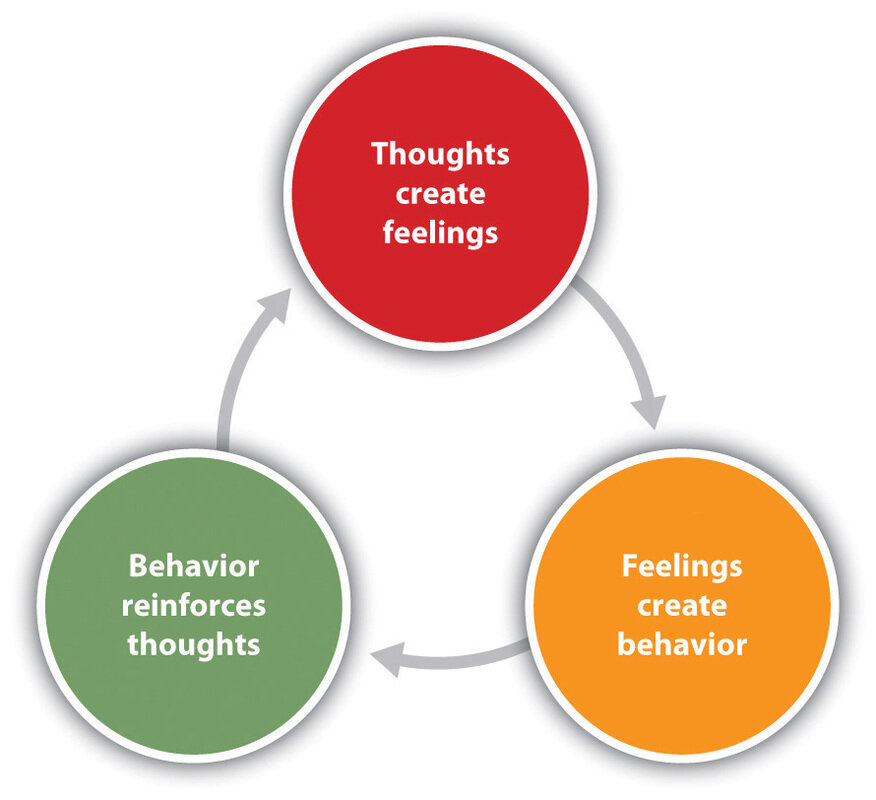It isn’t so much what happens to us in life that matters but how we think about it and how we respond to it.
- What we think affects how we feel and behave/act.
- What we feel affects how we think and behave/act.
- What we do (behavior) affects how we think and feel.

Image created for KennethMD by Ellen Acha
“The Three-Component Model of Emotions
From the CBT perspective, there are three components that make up our emotional experience. They are thoughts, feelings, and behaviors:
Thoughts
Thoughts refer to the ways that we make sense of situations. Thoughts can take a number of forms, including verbal forms such as words, sentences, and explicit ideas, as well as non-verbal forms such as mental images. Thoughts are the running commentary we hear in our minds throughout our lives.

Feelings
The term feelings here doesn’t refer to emotion, but the physiological changes that occur as a result of emotion. For instance, when we feel the emotion of anger, we have the feeling of our face flushing. When we feel the emotion of anxiety, we have the feelings of our heart pounding and muscles tensing. Feelings are the hard-wired physical manifestation of emotion.
Behaviors
Behaviors are simply the things we do. Importantly, behaviors are also the things we don’t do. For instance, if we feel overwhelming anxiety, we might bow out of a speaking engagement. On the other hand, if instead we feel confident, we might actually seek out those sorts of engagements.
As discussed in the introduction, each of these components interacts with the other to create moods and emotional patterns. Changing one component results in a chain reaction that changes the others.“ https://cogbtherapy.com/introduction-to-cbt
This is essentially using the three components of emotions: Cognitive (thoughts), Physiological changes, and Behavior, where the physiological changes are called Feelings.
“CBT is based on the work of American psychiatrist Aaron Beck, who reasoned that some persons learn to perceive self, personal world, and the future in a biased fashion. Through a variety of cognitive errors, a person may develop dysfunctional beliefs that lead to ineffective behavior (coping), depressed mood, and unpleasant physical symptoms. Automatic thoughts that are derived from dysfunctional beliefs (cognitive schema) are thought to be the central element maintaining depressed mood.” AAFP 2012
KTA
-A key principle underlying CBT is that emotions drive behavior, but thinking drives emotions. How you think determines how you feel. If you change how you think, it changes how you feel. Thinking and feeling are not as separate and “opposites”, as we are often led to believe. Instead, they influence each other.
-Sabotaging thoughts often preceded bad choices, like deciding to eat that ice cream or cake when you shouldn’t.
-The main belief of CTB: It isn’t so much what happens to us in life that matters but how we think about what has happened to us.
“Cognitive refers to thinking. One symptom that every depressed patient has is distortions in their thinking. One of the first things that you have to help patients understand is that just because I think something doesn’t necessarily mean it’s true.” Judith Beck Ph.D. [Daughter of Aaron Beck, the psychiatrist who is attributed to starting CBT).

Image created for KennethMD by Ellen Acha
Diseases that are treated with CBT.
References
https://www.ncbi.nlm.nih.gov/pubmedhealth/PMH0072481/
Am Fam Physician. 2012 Apr 1;85(7):686-687. Integrating Cognitive Behavioral Therapy into the Management of Depression.
Am Fam Physician. 2015 Nov 1;92(9):807-812. https://www.aafp.org/afp/2015/1101/p807.html
https://en.wikipedia.org/wiki/Aaron_T._Beck

